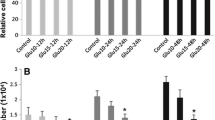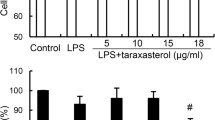Abstract
This study was aimed to determine if excessive exposure to fluoride could suppress the synthesis of nitric oxide (NO) and to detail the mechanisms involved. With the exception of the control group, human umbilical vein endothelial cells (HUVECs) were treated with sodium fluoride (NaF) (1.2 μg/mL) for 24 h, with or without a 2-h pretreatment with 100 nM insulin-like growth factor 1 (IGF-1, a PI3K/AKT agonist), or 10 μM histamine (HIS, a eNOS agonist). The levels of NO in culture fluids, as well as the expressions of eNOS, p-eNOS, PI3K, AKT, and p-AKT, were compared. The levels of NO significantly decreased in all experimental groups; however, the levels of NO were obviously higher in the NaF + HIS and NaF + IGF-1 groups, compared to the NaF group. The p-eNOS/eNOS ratios dropped clearly in NaF and NaF + HIS groups, while that in the NaF + HIS group was distinctly higher than that in the NaF group. The p-AKT/AKT ratios went down apparently in NaF and NaF + IGF-1 groups, while that in the NaF + IGF-1 group was overtly higher than that of the NaF group. Excessive exposure to fluoride inhibited the synthesis of NO. The PI3K/AKT/eNOS pathway played a crucial role in the reduced expression of NO caused by excessive fluoride exposure.



Similar content being viewed by others
References
Sun L, Gao Y, Sun D et al (2014) Effect of high fluoride and high fat on serum lipid levels and oxidative stress in rabbits. Environ Toxicol Pharmacol 38(3):1000–1006. https://doi.org/10.1016/j.etap.2014.10.010
Sun L, Gao Y, Sun D et al (2013) An assessment of the relationship between excess fluoride intake from drinking water and essential hypertension in adults residing in fluoride endemic areas. Sci Total Environ 443:864–869. https://doi.org/10.1016/j.scitotenv.2012.11.021
Liu H, Gao Y, Sun D et al (2014) Assessment of relationship on excess fluoride intake from drinking water and carotid atherosclerosis development in adults in fluoride endemic areas. Chin Int J Hyg Environ Health 217(2-3):413–420. https://doi.org/10.1016/j.ijheh.2013.08.001
Sun L, Gao Y, Sun D et al (2016) Mechanisms underlying endothelin-1 level elevation caused by excessive fluoride exposure. Cell Physiol Biochem 40(5):861–873. https://doi.org/10.1159/000453145
Vita JA (2011) Endothelial function. Circulation 124(25):e906–e912. https://doi.org/10.1161/CIRCULATIONAHA.111.078824
Endemann DH, Schifrin EL (2004) Endothelial dysfunction. J Am Soc Nephrol 15(8):1983–1992. https://doi.org/10.1097/01.ASN.0000132474.50966.DA
Wallace SM, McEniery CM et al (2007) Isolate systolic hypertension is characterized by increased aortic stiffness and endothelial dysfunction. Hypertension 50(1):228–233. https://doi.org/10.1161/HYPERTENSIONAHA.107.089391
Vanhoutte PM (2009) Endothelial dysfunction: the first step toward coronary arteriosclerosis. Circ J 73(4):595–601. https://doi.org/10.1253/circj.CJ-08-1169
Garthwaite J, Boulton CL (1995) Nitric oxide signaling in the central nervous system. Annu Rev Physiol 57(1):683–706. https://doi.org/10.1146/annurev.ph.57.030195.003343
Forstermann U, Closs EI, Pollock JS, Nakane M, Schwarz P, Gath I, Kleinert H (1994) Nitric oxide synthase isozymes. Characterization, purification, molecular cloning, and functions. Hypertension 23(6_Pt_2):1121–1131. https://doi.org/10.1161/01.HYP.23.6.1121
Dimmeler S, Fleming I, Fisslthaler B, Hermann C, Busse R, Zeiher AM (1999) Activation of nitric oxide synthase in endothelial cells by Akt-dependent phosphorylation. Nature 399(6736):601–605. https://doi.org/10.1038/21224
Isenovic ER, Meng Y, Jamali N, Milivojevic N, Sowers JR (2004) Ang II attenuates IGF-1-stimulated Na+, K(+)-ATPase activity via PI3K/Akt pathway in vascular smooth muscle cells. Int J Mol Med 13(6):915–922
Wang W, Xu B (2007) Effects of depside salt from salvia miltiorrhiza on platelet endothelial nitric oxide synthase activity. Chin J Hypertens 15(7):554–556
Yoshitomi H, Xu Q, Gao M, Yamori Y (2011) Phosphorylated endothelial NOS Ser1177 via the PI3K/Akt pathway is depressed in the brain of stroke-prone spontaneously hypertensive rat. J Stroke Cerebrovasc Dis 20(5):406–412. https://doi.org/10.1016/j.jstrokecerebrovasdis.2010.01.014
Author information
Authors and Affiliations
Corresponding author
Rights and permissions
About this article
Cite this article
Huang, Y., Sun, M., Li, F. et al. Preliminary Study of Mechanisms of Fluoride-Induced Suppression of Nitric Oxide Synthesis in Human Umbilical Vein Endothelial Cells. Biol Trace Elem Res 185, 311–315 (2018). https://doi.org/10.1007/s12011-018-1252-y
Received:
Accepted:
Published:
Issue Date:
DOI: https://doi.org/10.1007/s12011-018-1252-y




